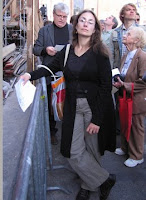
In a bureaucracy like France, there are rules of engagement dictating how things will work and those rules must be followed, step by step. Adopt the protocol and things will go swimmingly. Ignore the process, intentionally or not, and you will not get very far. In Italy, there are also rules and layers of procedures, but the rules are sometimes flexible and can change with each election. This is a country where two of the current President's most admired traits are that he gets things done amidst chaos, including things that shouldn't be done, and that he gets away with things that shouldn't be done.

Change here might mean that something once allowed has become unacceptable. The person thwarting you from a desk or window might be saying, “No way, no how, and not for any particularly good reason,” like the woman at the post office who claimed there was no such thing as a post card stamp, so we went to another post office to purchase them. Or perhaps the answer is, “You may not because the new administration's rules haven't been passed down yet, so no just in case.” And then there is the “No you may not until you shout like a lunatic silencing the angry figure who has appeared to impede you," which means you are going to get away with it. Getting away with something seems to be a well-practiced sport here involving hand gestures, a flushed face, and a steely resolve.

One of the more frustrating rule changes is the randomly enforced prohibition against photography at museums or cultural sites, which is especially vexing as these institutions were created by and for art. At some, guards stand by while visitors take pictures and at others, arms flail and eyes flash as a crazed form approaches ranting madly. In these instances, you tuck the camera away immediately, into your pocket or under your arm. These photos were all taken against the rules, usually from my pocket or under my arm just to see what I would get, which is to say, what I would get away with while getting yelled at.

We visited the Sistine Chapel on one of those rainy late fall/almost winter days, when the little bit of gloomy light has disappeared by four in the afternoon. From the front entrance to the chapel, a guard shouts “Quiet!”every few minutes. The wandering masses pause for a brief second as if in detention, their necks craned and their heads titled towards the ceiling. Another guard patrols the crowd. There is a confusing sign with a symbol of a camera and a flash and an X over the drawing. Photography is permitted along the route to the Sistine Chapel, so I began taking photographs of people staring at the ceiling when the circling guard descended and demanded, “You will now erase.” (It is okay to photograph Raphael, but not Michelangelo apparently.) He stood over me as I punched buttons on the camera and then I lied, “Sorry. I deleted them.”

Not satisfied, the guard glared at me intensely as I put my camera in my bag. He asked, “Why would you take photographs? There is a sign.” I explained that the sign had a flash and so I was confused as photography is allowed throughout the Vatican. He repeated, “Why? Why would you take a picture? The sign is very clear.” I apologized once more and noted that others were taking pictures as well, so the sign is not terribly clear. (One should never try to explain anything in a situation like this one.) The guard locked his eyes on my face and reiterated over and over that the sign could not possibly be misunderstood by anyone. I was beginning to wonder what I should say besides, “I’m sorry” to make the guard leave me alone when my friend stared him down and said in a deep, stern voice, “She said she’s sorry; she won’t take more pictures.” The guard immediately turned away to pester another couple nearby. In Rome, whether one is enforcing the rules or breaking the rules, a forceful tone, (accompanied by glaring and hand gestures) is the way to get away with it.




















